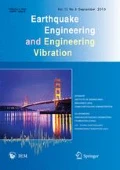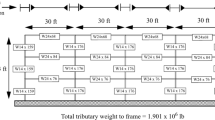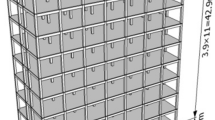Abstract
This paper presents a procedure to develop fragility curves of structures equipped with TMD considering multiple failure functions. The failure criteria considered are maximum inter-story drift ratio as a safety criterion, maximum absolute acceleration as a convenience criterion and TMD stroke length. The relationship between intensity measure and responses of the structure was assumed to follow the power-law model, and a regression analysis was used to estimate its properties. A nonlinear eight-story shear building subjected to near-fault earthquakes was used for the numerical studies. Fragility curves using multiple and single failure functions for an uncontrolled structure and a structure equipped with optimal TMDs were developed. Numerical analysis showed that using multiple failure functions led to increasing the fragility when compared with using the single failure function for both the uncontrolled and controlled structures. However, TMDs slightly reduced the seismic fragility and have the capability to improve the reliability of the structure. Also, it was found that the fragility was significantly influenced by the values of the capacity thresholds of both the acceleration of the structure and TMD stroke length, which should be selected by considering the target performance and application of the structure and control device.
Similar content being viewed by others
References
Ahmad S, Kyriakides N, Pilakoutas K, Neocleous K and Zaman QU (2015), “Seismic Fragility Assessment of Existing Sub-Standard Low Strength Reinforced Concrete Structures,” Earthquake Engineering and Engineering Vibration, 14(3): 439–452.
Andriotis CP and Papakonstantinou KG (2017), “Generalized Multivariate Fragility Functions with Multiple Damage States,” 12th International Conference on Structural Safety and Reliability, Vienna, Austria, August 2017.
Bagheri S and Rahmani-Dabbagh V (2018), “Seismic Response Control with Inelastic Tuned Mass Dampers,” Engineering Structures, 172(Oct): 712–722.
Bakre SV and Jangid RS (2007), “Optimum Parameters of Tuned Mass Damper for Damped Main System,” Structural Control and Health Monitoring, 14(3): 448–470.
Barnawi W (2008), “Seismic Fragility Relationships for Civil Structures Retrofitted with Semi-Active Devices,” Master’s Thesis, Washington Univ., St. Louis, USA.
Barnawi W and Dyke SJ (2014), “Seismic Fragility Relationships of a Cable-Stayed Bridge Equipped with Response Modification Systems,” Journal of Bridge Engineering, 19(8): A4013003.
Bayat M, Daneshjoo F and Nistico N (2017), “The Effect of Different Intensity Measures and Earthquake Directions on the Seismic Assessment of Skewed Highway Bridges,” Earthquake Engineering and Engineering Vibration, 16(1): 165–179.
Biasio MD (2014), “Ground Motion Intensity Measure for Seismic Probabilistic Risk Analysis,” PhD Thesis, University of Grenoble, France.
Castaldo P, Amendola G and Palazzo B (2017), “Seismic Fragility and Reliability of Structures Isolated by Friction Pendulum Devices: Seismic Reliability-Based Design (SRBD),” Earthquake Engineering and Structural Dynamics, 46(3): 425–446.
Castaldo P, Amendola G and Ripani M (2018), “Seismic Fragility of Structures Isolated by Single Concave Sliding Devices for Different Soil Conditions,” Earthquake Engineering and Engineering Vibration, 17(4): 869–891.
Choi E, Youn H and Cho BS (2016), “Probabilistic Seismic Performance Assessment of Lap-Spliced RC Columns Retrofitted by Steel Wrapping Jackets,” Earthquake Engineering and Engineering Vibration, 15(2): 223–238.
Cimellaro GP and Reinhorn AM (2011), “Multidimensional Performance Limit State for Hazard Fragility Functions,” Journal of Engineering Mechanics, 137(1): 47–60.
Cornell CA, Jalayer F, Hamburgur RO and Foutch DA (2002), “Probabilistic Basic for 2000 sac Federal Emergency Management Agency Steel Moment Frame Guidelines,” Journal of Structural Engineering, ASCE, 128(4): 526–533.
Ellingwood BR (2001), “Earthquake Risk Assessment of Building Structures,” Reliability Engineering and System Safety, 74(3): 251–262.
Estes AC and Frangopol DM (1999), “Repair Optimization of Highway Bridges Using System Reliability Approach,” Journal of Structural Engineering, ASCE, 125(7): 766–775.
Estes AC and Frangopol DM (2001), “Bridge Lifetime System Reliability under Multiple Limit States,” Journal of Bridge Engineering, 6(6): 523–528.
FEMA 356 (2000), Prestandard and Commentary for the Seismic Rehabilitation of Buildings, Federal Emergency Management Agency, Washington, D.C., USA.
FEMA P-58 (2012), Next-Generation Seismic Performance Assessment for Buildings, Volume 1 — Methodology, Applied Technology Council, Federal Emergency Management Agency, Washington, D.C., USA.
Gavin HP and Yau SC (2008), “High-Order Limit State Functions in the Response Surface Method for Structural Reliability Analysis,” Structural Safety, 30(2): 162–179.
Guo AX, Xu YL and Wu B (2002), “Seismic Reliability Analysis of Hysteretic Structure with Viscoelastic dampers,” Engineering Structures, 24(3): 373–383.
Guo W, Wu J, Hu Y, Li Y and Yang TY (2019), “Seismic Performance Evaluation of Typical Dampers Designed by Chinese Building Code,” Earthquake Engineering and Engineering Vibration, 18(2): 433–446.
Jalayer F (2003), “Direct Probabilistic Seismic Analysis: Implementing Non-Linear Dynamic Assessments,” PhD Thesis, Stanford University, CA, USA.
Kaplan S, Perla HF and Bley DC (1983), “A methodology for Seismic Risk Analysis of Nuclear Power Plant,” Risk Analysis, 3(3): 169–180.
Kazemi H, Ghafory-Ashtiany M and Azarbakht A (2017), “Development of Fragility Curves by Incorporating New Spectral Shape Indicators and a Weighted Damage Index: Case Study of Steel Braced Frames in the City of Mashhad, Iran,” Earthquake Engineering and Engineering Vibration, 16(2): 383–395.
Kennedy RP, Cornell CA, Campbell RD, Kaplan S and Perla HF (1980), “Probabilistic Seismic Safety Study of an Existing Nuclear Power Plant,” Nuclear Engineering and Design, 59(2): 315–338.
Li HS, Ma YZ and Cao Z (2015), “A Generalized Subset Simulation Approach for Estimating Small Failure Probabilities of Multiple Stochastic Responses,” Computers and Structures, 153: 239–251.
Lu H and Zhang Y (2011), “Reliability-Based Robust Design for Structural System with Multiple Failure Modes,” Mechanics Based Design of Structures and Machines, 39(4): 420–440.
Mohebbi M and Joghataie A (2012), “Designing Optimal Tuned Mass Dampers for Nonlinear Frames by Distributed Genetic Algorithms,” The Structural Design of Tall and Special Buildings, 21(1): 57–76.
Newmark NM (1959), “A Method of Computing for Structural Dynamics,” Journal of the Engineering Mechanics Division, 85(3): 67–94.
Park YJ, Ang AHS and Wen YK (1985), “Seismic Damage Analysis of Reinforced Concrete Buildings,” Journal of Structural Engineering, ASCE, 111(4): 740–757.
Perrault M, Gueguen P, Aldea A and Demetriu S (2013), “Using Experimental Data to Reduce the Single-Building Sigma of the Fragility Curves: Case Study of the BRD Tower in Bucharest, Romania,” Earthquake Engineering and Engineering Vibration, 12(4): 643–658.
PGMD (2011), <http://peer.berkeley.edu/peer_ground_motion_database/>.
Ramezani M, Bathaei A and Ghorbani-Tanha AK (2018), “Application of Artificial Neural Networks in Optimal Tuning of Tuned Mass Dampers Implemented in High-Rise Buildings Subjected to Wind Load,” Earthquake Engineering and Engineering Vibration, 17(4): 903–915.
Reinhorn AM, Lavan O and Cimellaro GP (2009), “Design of Controlled Elastic and Inelastic Structures,” Earthquake Engineering and Structural Dynamics, 8(4): 469–479.
Risi RD, Goda K and Tesfamariam S (2019), “Multi-Dimensional Damage Measure for Seismic Reliability Analysis,” Structural Safety, 78(May): 1–11.
Sadek F, Mohraz B, Taylor AW and Chung RM (1997), “A Method of Estimating the Parameters of Tuned Mass Dampers for Seismic Applications,” Earthquake Engineering and Structural Dynamics, 26(6): 617–635.
Sfahani MG, Guan H and Loo YC (2015), “Seismic Reliability and Risk Assessment of Structures Based on Fragility Analysis — A Review,” Advances in Structural Engineering, 18(10): 1653–1669.
Shome N and Cornell CA (1999), “Probabilistic Seismic Demand Analysis of Nonlinear Structures,” RMS Report 35 Reliability of Marine Structures Group, Stanford University, Stanford.
Song S, Qian Y, Liu J, Xie X and Wu G (2019), “Time-Variant Fragility Analysis of the Bridge System Considering Time-Varying Dependence Among Typical Component Seismic Demands,” Earthquake Engineering and Engineering Vibration, 18(2): 363–377.
Soto MG and Adeli H (2013), “Tuned Mass Dampers,” Archives of Computational Methods in Engineering, 20(4): 419–431.
Spencer BF and Nagarajaiah S (2003), “State of the Art of Structural Control,” ASCE Journal of Structural Engineering, 129(7): 845–856.
Stephens J and Yao JTP (1987), “Damage Assessment Using Response Measurements,” Journal of Structural Engineering, ASCE, 113(4): 787–801.
Su RKL and Lee CL (2013), “Development of Seismic Fragility Curves for Low-Rise Masonry Infilled Reinforced Concrete Buildings by a Coefficient-Based Method,” Earthquake Engineering and Engineering Vibration, 12(2): 319–332.
Taylor E (2007), “The Development of Fragility Relationships for Controlled Structures,” Master’s Thesis, Washington Univ., St. Louis.
Taylor E, Barnawi W and Dyke SJ (2008), “Development of Fragility Relationships for Smart Structures,” Proc. World Forum on Smart Materials and Smart Structures Technology, Taylor & Francis, London.
Tubaldi E, Barbato M and Dall’Asta A (2014), “Performance-Based Seismic Risk Assessment for Buildings Equipped with Linear and Nonlinear Viscous Dampers,” Engineering Structures, 78: 90–99.
Vamvatsikos D and Cornell CA (2005), “Seismic Performance, Capacity and Reliability of Structures as Seen Through Incremental Dynamic Analysis,” Report No. 151, Department of Civil and Environmental Engineering, Stanford University.
Vetr MG, Nouri AR and Kalantari A (2016), “Seismic Evaluation of Rocking Structures Through Performance Assessment and Fragility Analysis,” Earthquake Engineering and Engineering Vibration, 15(1): 115–127.
Wang Q, Wu Z and Liu S (2012), “Seismic Fragility Analysis of Highway Bridges Considering Multi-Dimensional Performance Limit State,” Earthquake Engineering and Engineering Vibration, 11(2): 185–193.
Wen YK, Ellingwood BR and Bracci J (2004), Vulnerability Functions Framework for Consequence-Based Engineering, DS-4 Rep., Mid-America Earthquake Center, Urbana, IL.
Wilbee AK, Pena F, Condori J, Sun Z and Dyke SJ (2015), “Fragility Analysis of Structures Incorporating Control Systems,” 6th International Conference on Advanced in Experimental Structural Engineering, University of Illinois, Urbana-Champaign, United States.
Wong KKF and Harris JL (2012), “Seismic Damage and Fragility Analysis of Structures with Tuned Mass Dampers Based on Plastic Energy,” The Structural Design of Tall and Special Buildings, 21(4): 296–310.
Zhang J, Hou Y, Brandenberg SJ and Kashighandi P (2008), “Effects of Structural Characterizations on Fragility Functions of Bridges Subject to Seismic Shaking and Lateral Spreading,” Earthquake Engineering and Engineering Vibration, 7(4): 369–382.
Author information
Authors and Affiliations
Corresponding author
Rights and permissions
About this article
Cite this article
Bakhshinezhad, S., Mohebbi, M. Multiple failure function based fragility curves for structures equipped with TMD. Earthq. Eng. Eng. Vib. 20, 471–482 (2021). https://doi.org/10.1007/s11803-021-2032-9
Received:
Accepted:
Published:
Issue Date:
DOI: https://doi.org/10.1007/s11803-021-2032-9




